Jeff Beck’s 10 most iconic guitars
From the Oxblood Les Paul and the Strat we all know and love to Beck's lesser-spotted favorites, here are the greatest hits from one of guitar's finest collections
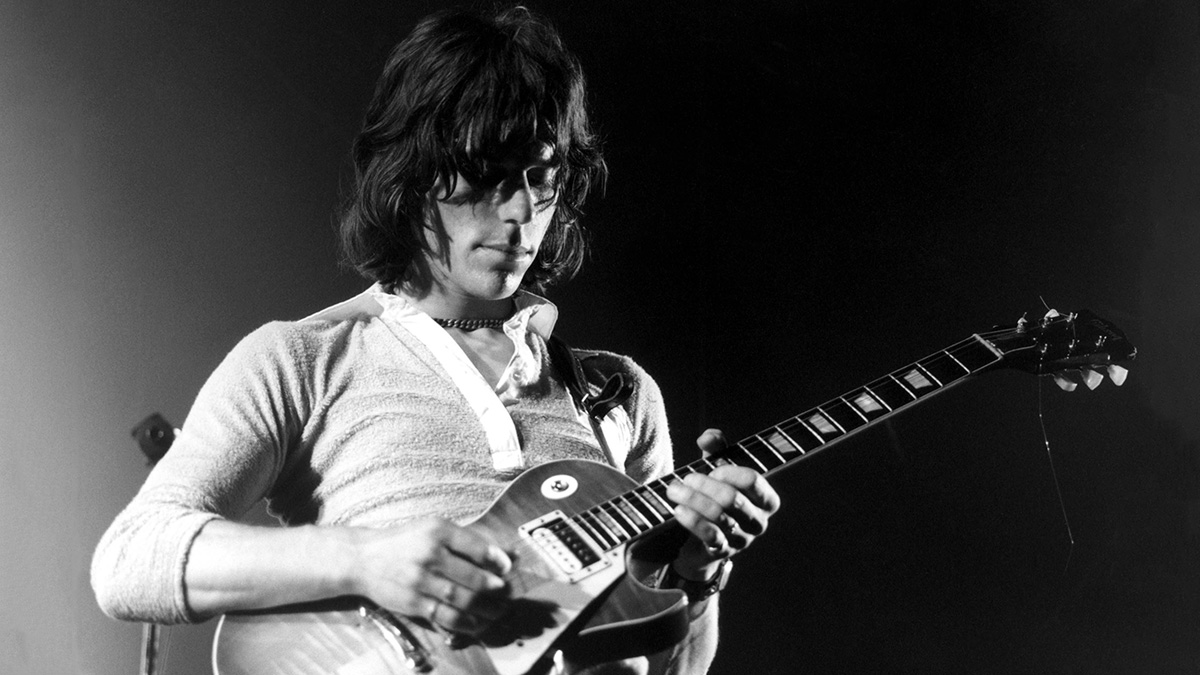
In January 2016, Jeff Beck asked me to write historical and basic technical info about 10 of his favorite guitars for his book Beck01: Hot Rods and Rock & Roll published by Genesis Publications.
The publisher recommended me for the project based on the work I did on Eric Clapton’s Six String Stories, and since I had previously interviewed Jeff about half a dozen times, he was very comfortable with my input and involvement.
It was one of the highest honors in my career to be hand-picked for the project. Jeff was one of my biggest guitar influences since day one, as well as a dear friend.
The following guitars represent a great overview of Beck’s career from his groundbreaking stint in the Yardbirds through his very last shows in November 2022 with Johnny Depp. Yes, a few key instruments are missing (like the white mid-Seventies Strat he played on Blow by Blow and Wired), but the inclusion of a few personal favorites that he only played at home and never previously revealed to the public make up for it.
Beck01 features large, detailed photos of each instrument, but unfortunately for readers who would like a closer look, the limited-edition book is long sold out and plans for a general release have not been announced.
1. 1954 Fender Esquire
While Jeff Beck’s iconic Fender Esquire which he played with the Yardbirds started life as a 1954 model, it is actually constructed of various parts from the ’50s thanks to modifications that he made to the instrument.
When Beck bought the Esquire from John Walker (née Maus) of the Walker Brothers, the guitar still had its original white pickguard, but Jeff quickly replaced it with a black Esquire pickguard because he preferred the look of Fender’s earlier Esquire/Telecaster models.
Get The Pick Newsletter
All the latest guitar news, interviews, lessons, reviews, deals and more, direct to your inbox!
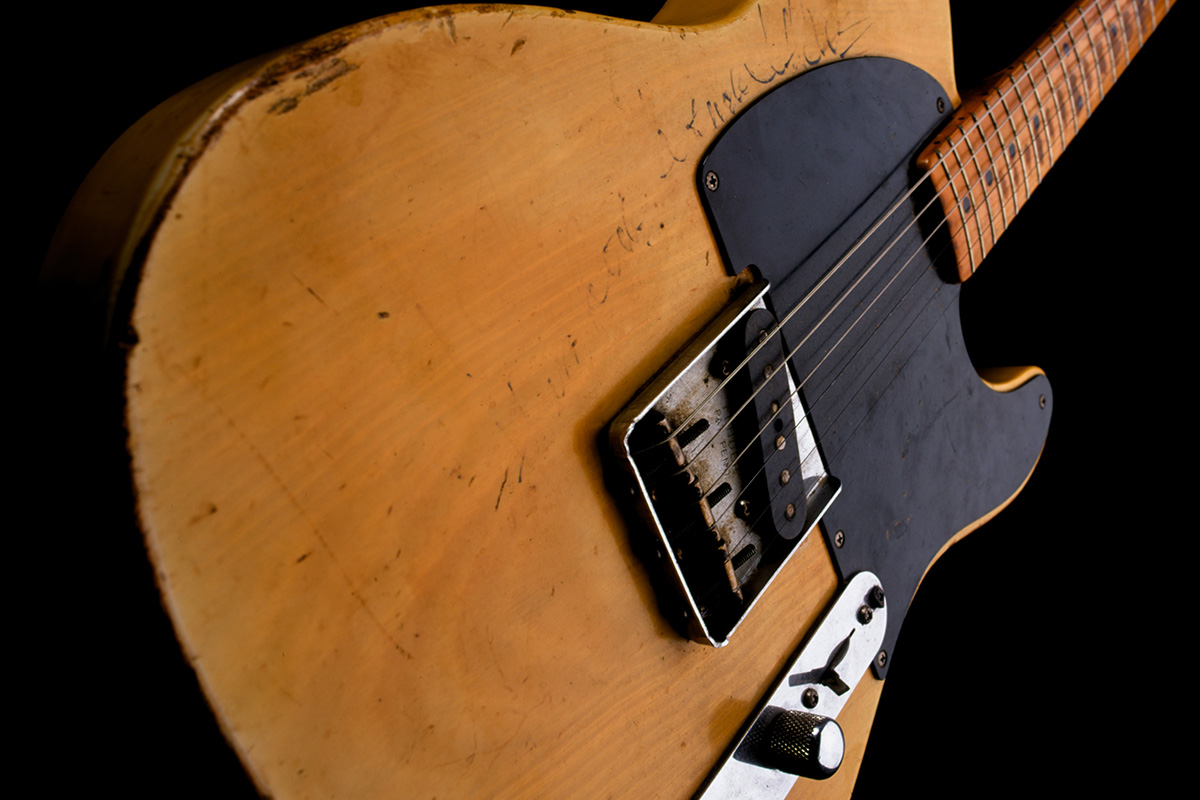
Because the original steel saddles were rusted, Jeff replaced them with brass saddles from a 1952 Telecaster. The original neck was also broken at one point and replaced with the 1955 Esquire neck it has now.
However, the guitar’s most visible and recognizable modification was performed before Jeff acquired the Esquire. John Walker carved the contours on the front of the body’s lower bass bout and rear of the body’s waist in an attempt to replicate a Stratocaster’s comfortable feel.
2. 1959 Gibson Les Paul Standard
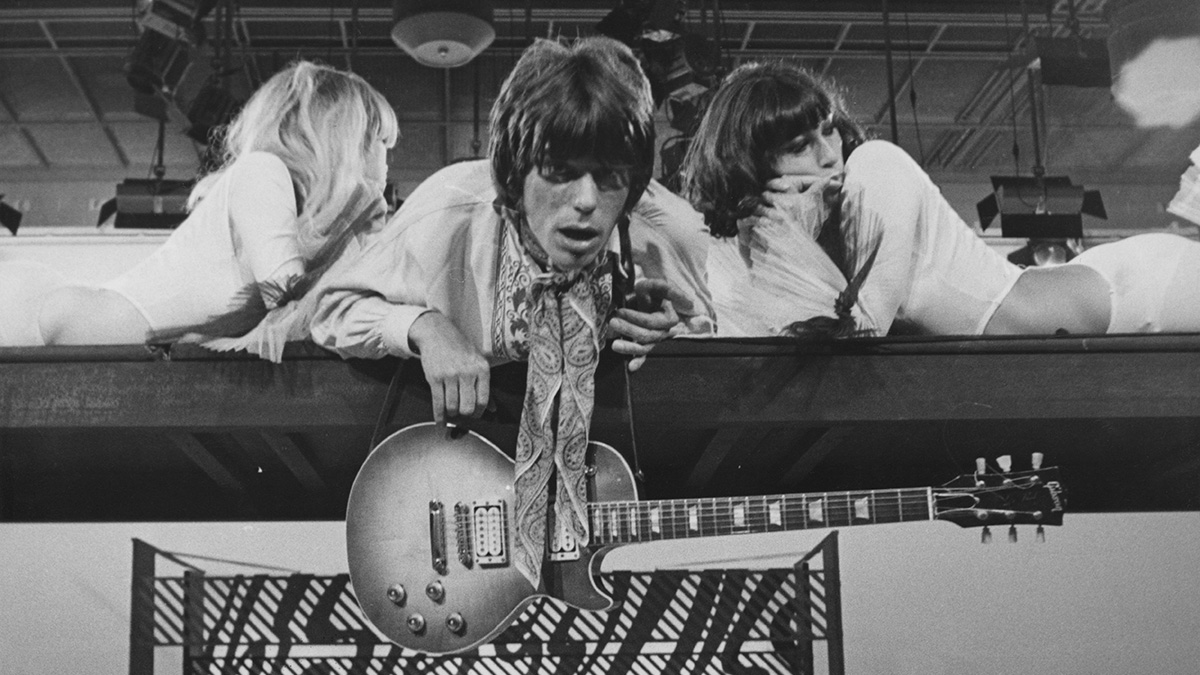
Beck bought his first Les Paul – a 1959 Standard – in early 1966 just before the Yardbirds began recording sessions for the Roger the Engineer album. The guitar originally had a cherry sunburst finish, but sometime around late 1967 or early 1968 he stripped off the finish and left the top in its natural, unfinished state. He also removed the black pickguard that was on the guitar prior to stripping its finish.
Beck played this guitar in the studio and frequently on stage with the Jeff Beck Group during the late ’60s, but after the neck suffered damage in late 1968 he acquired another late-’50s sunburst Les Paul with exquisite curly maple figuring as a replacement while this guitar was repaired (that sunburst Les Paul was later stolen).
The neck currently seen on this guitar, which features an L-5-style headstock with flowerpot inlay, non-original trapezoid fingerboard inlays and Jeff’s initials inlaid at the 22nd fret, was a custom-made replacement installed during the mid ’70s by Strings & Things in Memphis. The original cream-color humbuckers were also replaced by black pickups during an earlier repair.
3. 1954 Gibson Les Paul
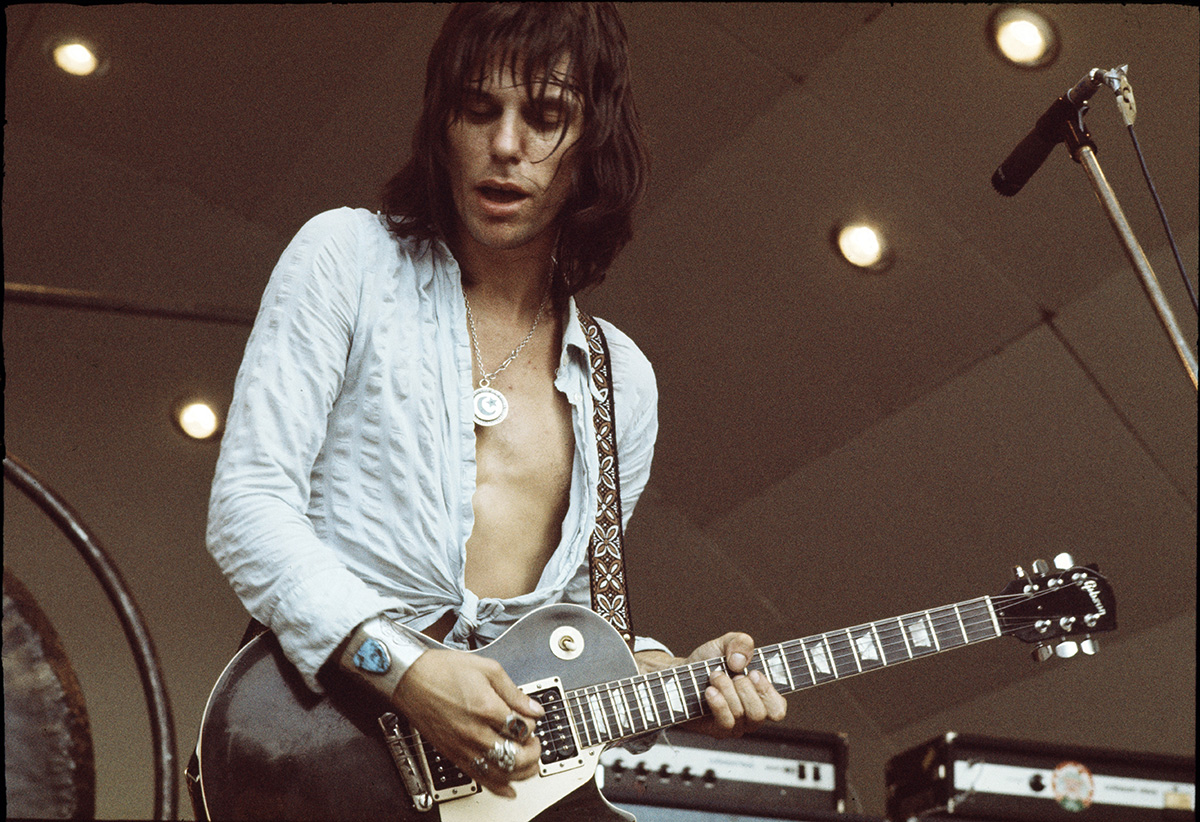
In November 1972 while Jeff was passing through Memphis on tour with Beck, Bogert & Appice (still called the Jeff Beck Group at the time), he bought this guitar from a fan named Buddy Davis. Originally it was a 1954 Les Paul Goldtop, but apparently the owner, Robert “Butch” Johnson, took it to Strings & Things in Memphis and asked them to refinish it chocolate brown and install two humbucking pickups.
The owner wasn’t satisfied with the work so he traded it in and Buddy bought it. When Buddy was driving Jeff to various stores around Memphis to help him find a guitar to replace his flame-maple sunburst Les Paul that was stolen in upstate New York earlier that year, Beck immediately fell in love with Buddy’s guitar with its distinctive dark brown “oxblood” finish and offered to buy it from him.
The oxblood Les Paul immediately became Beck’s main instrument on stage with Beck, Bogert & Appice, but it is best known as the guitar that appears in his hands on the cover of his first solo album, Blow by Blow. It’s also one of four guitars, along with two Stratocasters and a 1958 Telecaster featuring a pair of humbucking pickups installed by Seymour Duncan, that Beck used to record Blow by Blow.
The guitar’s combination of ’54 Les Paul features such as its single-piece wraparound tailpiece/bridge with later Les Paul features like humbucking pickups and a shaved neck profile gives it a very distinctive tone.
4. Early ’80s Jackson Soloist
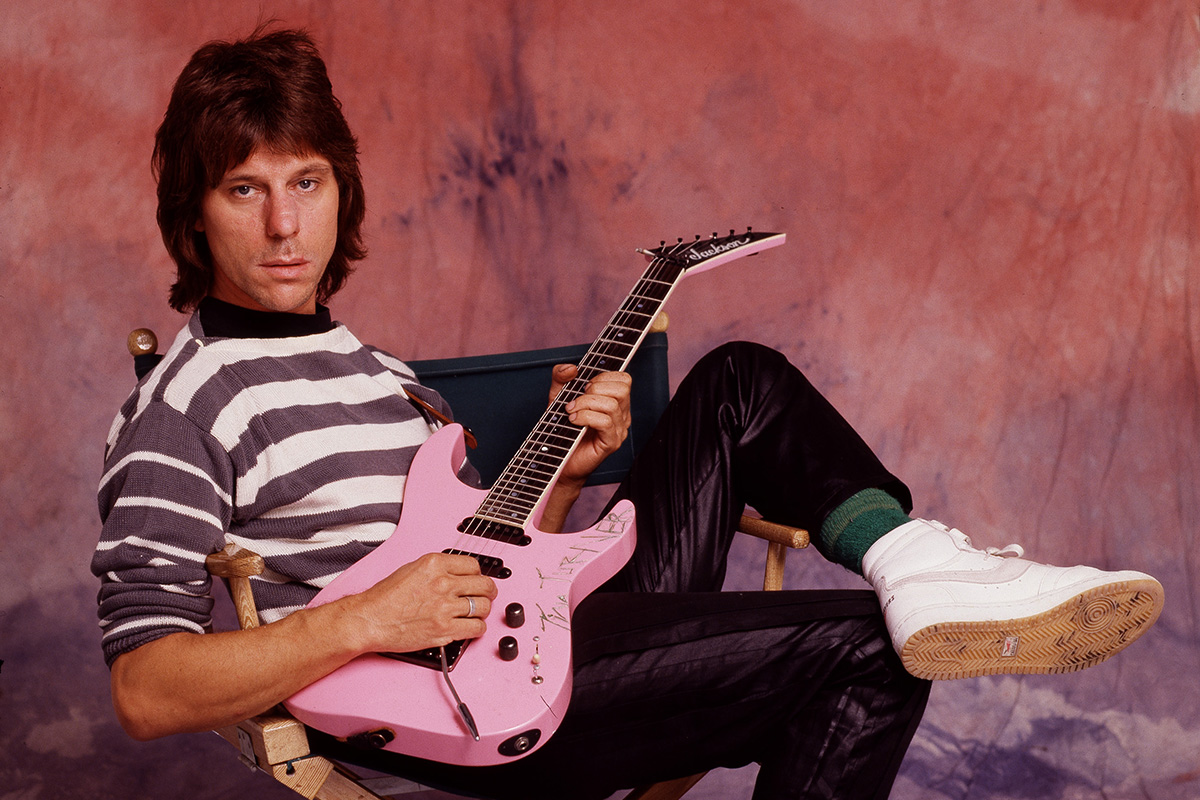
It’s fitting that the concept of the hot-rodded guitar originated in Southern California as that locale was also the birthplace of the hot rod car phenomenon. During the late ’70s and early ’80s, Jackson/Charvel was one of several companies in Southern California that specialized in making Strat-style custom guitars with flashy finishes, high-output pickups, state-of-the-art double-locking tremolos, and slender necks that were built for speed. This design eventually became known as the “super Strat”.
Jeff acquired this pink Jackson Soloist in 1983 and played it throughout the mid-’80s, including at a few ARMS benefit concerts and on the hits Private Dancer with Tina Turner and People Get Ready, his reunion with Rod Stewart.
Notable features of this guitar include its neck-through-body construction, 24-fret neck and Kahler double-locking tremolo. However, the ne plus ultra feature of this guitar is Tina Turner’s signature on the treble bout, which she scratched into the guitar’s face with a knife.
5. 1956 Gretsch 6128 Duo Jet
About 10 years before Beck recorded the Crazy Legs album – his tribute to Cliff Gallup, guitarist with Gene Vincent and his Blue Caps – he searched for a Gretsch 6128 Duo Jet like the one played by Gallup to duplicate Gallup’s signature sound.
First he acquired a 1963 model, which he said was “totally wrong,” but eventually he found a 1956 model that was in pieces. He rebuilt the guitar and installed a swivel-arm Bigsby on the ’56 Duo Jet, which he later used to record 1993’s Crazy Legs.
While the sound of this Duo Jet was close to Gallup’s, shortly after completing the album in 1992 Jeff found another ’56 Duo Jet (pictured above) with the missing link – a factory-installed fixed-arm Bigsby identical to the one on Gallup’s guitar.
“It’s got a depth, clarity and quality that the other one doesn’t have,” he said. “It’s incredible. Everything is as close to Cliff’s guitar as one can see. I wish I could have used it on the record.” Jeff played this Duo Jet frequently on stage, and it plays a starring role in the Rock ’n’ Roll Party (Honoring Les Paul) video release of his tribute concert for Les.
6. c. early ’90s-2003 Gretsch 6022 Rancher
Another Gretsch guitar played an important role in Gene Vincent’s music, although its powerful effect was more visual than aural. A photo taken at Hollywood’s Capitol Studios in 1957 shows Vincent strumming a Gretsch 6022 Rancher flattop acoustic, his legs spread in a classic rock ’n’ roll pose with the Blue Caps huddled in a triangular formation behind him.
Blue Caps rhythm guitarist Paul Peek also aggressively strummed a Gretsch Rancher when performing with Vincent in the film The Girl Can’t Help It, which introduced many young impressionable minds to the irresistible energy of rock ’n’ roll.
Jeff’s Rancher is a more recent model made in Japan sometime between the early ’90s and 2003 when Fender bought Gretsch. With its traditional saddle and pin bridge, it sounds better than original ’50s Gretsch Ranchers, which have an unorthodox triangular “harp” bridge. This example also has a Western-inspired “G” brand and engraved block inlays similar to the original 1954-56 Ranchers.
7. 2003 Fender Jeff Beck Custom Shop Signature Stratocaster
Fender Custom Shop master builder Todd Krause built this Stratocaster for Jeff in 2003. According to Krause, it is one of two guitars he made that were custom painted by Roy Brizio, the acclaimed street rod designer and builder who made several cars for Jeff.
The metallic bronze finish with distinctive black and white pinstriping details matches the paint job of a street rod that Brizio was building for Jeff at the time. Krause says that other than the finish, the guitar is a standard Jeff Beck Custom Shop Signature Stratocaster with hot noiseless pickups, a Wilkinson roller nut, Sperzel locking tuners and a contoured neck heel.
Fender officially introduced its custom color option in 1957. The concept was born shortly before then when Leo Fender’s associate George Fullerton visited an automotive paint shop and purchased some Fiesta Red DuPont Duco paint to finish a guitar.
Fender’s original DuPont Duco custom color guitars match the colors of various Cadillacs, Corvettes and other Chevrolet models built during this era. This Stratocaster with its Roy Brizio street rod-style paint job is a natural evolution of Fender’s custom color concept and a fitting crowning touch for a custom-made guitar.
8. 2006 Fender Custom Shop Jeff Beck Relic Esquire
In 2006, the Fender Custom Shop produced 150 exact replicas of the 1954 Fender Esquire that Beck played with the Yardbirds. Pickup manufacturer Seymour Duncan, who acquired the Esquire from Beck in the ’70s and kept it in its original, untouched condition, loaned the guitar to Fender so they could examine, measure and duplicate every exact detail.
Fender master builder Chris Fleming painstakingly replicated the V-shaped profile of the neck, the contours that John Walker carved in the body and every scrape, scratch and ding on the body, neck and pickguard. Fender veteran Abby Ybarra, who worked for the company since 1956, even wound the pickup for each replica guitar by hand.
9. c. 1965-71 Guild Stuart X-500 B
Guild’s hollowbody electric models were never quite as popular as those made by Gibson and Gretsch, even though the quality was generally comparable. The “Stuart” X-500 was Guild’s flagship archtop electric model upon its introduction in 1953, and thanks to its popularity it remained in continuous production up until 1993.
Although Beck never played this Guild on stage or in the studio, it was one of his favorite guitars as it reminded him of the hollowbody archtops played by rockabilly guitarists like Scotty Moore that he admired as a young child. Jeff’s Guild X-500 B (with “B” designating the blonde finish) dates from between 1965 through 1971.
Just like many street rod enthusiasts will put a Ford motor in a Chevy body, this X-500 had its original humbucking pickups swapped out for Gibson-style Seymour Duncan Antiquity P90 Dog Ear pickups
Distinguishing characteristics for this brief period include the center-raised headstock shape, large triangular abalone fretboard inlay inserts, Grover Rotomatic tuners, four controls and a Guild-branded Bigsby vibrato.
However, just like many street rod enthusiasts will put a Ford motor in a Chevy body, this X-500 had its original humbucking pickups swapped out for Gibson-style Seymour Duncan Antiquity P90 Dog Ear pickups, and a Gibson Tuneomatic replaced the original rosewood bridge.
The gold Guild knobs date from the ’50s. The custom pinstriping on the gorgeously figured curly maple back adds an appropriate decorative touch for a hot-rodded guitar like this.
10. c. mid-2010s White Jeff Beck Signature Strat
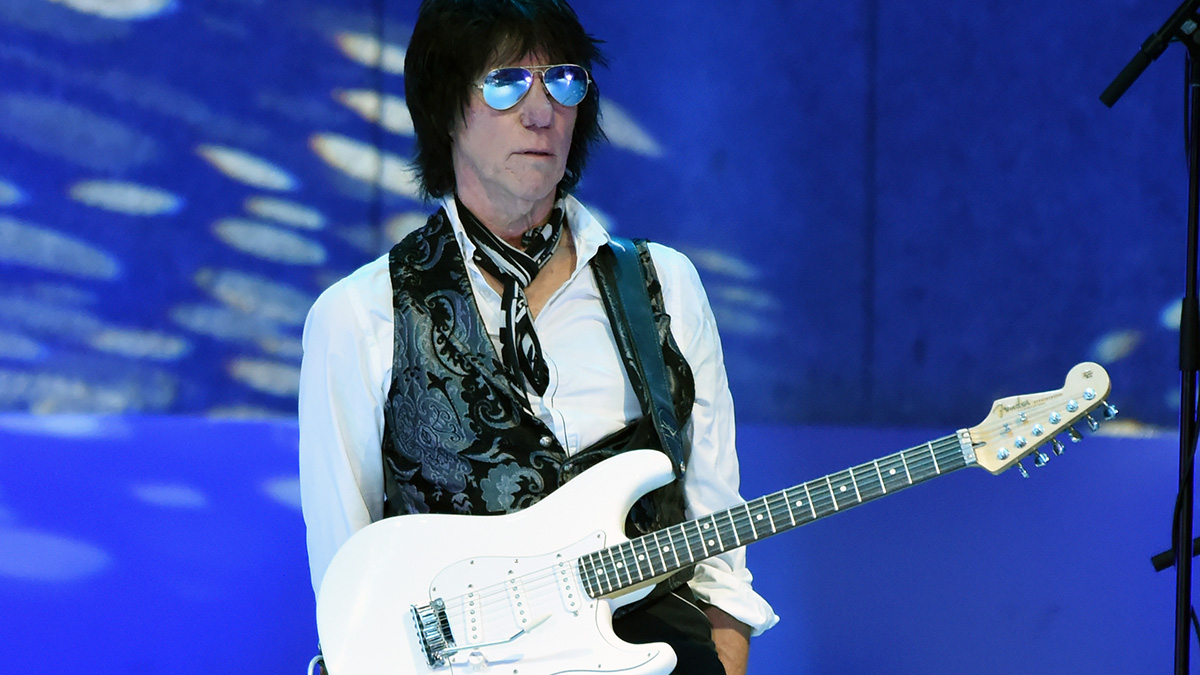
The Fender Jeff Beck Signature Stratocaster has remained a perennial best seller since its introduction in 1990, but it has undergone only two changes over the years – an upgraded version introduced in 2001 and a Custom Shop model officially introduced in 2004.
However, Jeff’s main Stratocasters have changed frequently over that same time period. The guitar shown here was Jeff’s main Stratocaster from the mid-2010s through his final shows with Johnny Depp in late 2022.
The most notable feature of this guitar is a neck built for a left-handed Strat, which places the arrangement of the tuners in reverse order. This also reverses the tension of the strings, making the high E and B strings much easier to bend and the low E and A strings more percussive and brilliant.
Some consider this an essential element of Jimi Hendrix’s distinctive Strat tones, as Hendrix played left-handed and strung a right-handed Strat in reverse order and flipped the guitar over. Jeff’s personal custom Strats also feature Wilkinson roller nuts, whereas current Fender Jeff Beck Signature models are equipped with LSR roller nuts.
Chris is the co-author of Eruption - Conversations with Eddie Van Halen. He is a 40-year music industry veteran who started at Boardwalk Entertainment (Joan Jett, Night Ranger) and Roland US before becoming a guitar journalist in 1991. He has interviewed more than 600 artists, written more than 1,400 product reviews and contributed to Jeff Beck’s Beck 01: Hot Rods and Rock & Roll and Eric Clapton’s Six String Stories.



![[from left] George Harrison with his Gretsch Country Gentleman, Norman Harris of Norman's Rare Guitars holds a gold-top Les Paul, John Fogerty with his legendary 1969 Rickenbacker](https://cdn.mos.cms.futurecdn.net/TuH3nuhn9etqjdn5sy4ntW.jpg)







